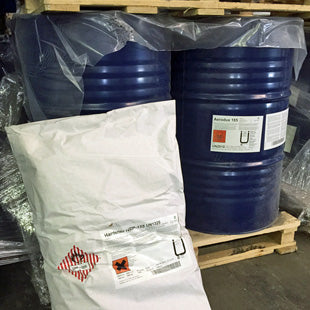Moisture Content
Controlling Moisture Content is the Key
As Seen In Wood & Wood Products Magazine
Excerpted from An Industry Review: Ten Ways of Eliminating Wood Problems by Dr. Eugene Wengert of the University of Wisconsin - Madison, Department of Forestry.
At least 75 percent of the wood manufacturing problems I review in the university’s Forestry Department are moisture related. That is why wood problems begin and end with monitoring and controlling the moisture content (MC) in wood.
WOOD 101 - THE BASICS
As the moisture content in wood changes, wood expands or contracts and this in turn causes a variety of problems. The moisture content of wood is measured as a ratio between the weight of the water in the wood and the weight of the wood itself. This ratio is stated as a percentage.
Freshly forest-cut "green" wood may have a moisture content of 30% to more than 200%, depending on the species. Before using any wood, it needs to be dried to reduce its moisture content. The "ideal" moisture content depends upon the use of the wood and the annual average relative humidity at the place where the wood is to be used. It is critical that the wood you work with be dried down to an MC within 2 percentage points of the equilibrium moisture content (EMC) of the in-use location. The EMC of air is numerically equal to the MC that will eventually be attained by any piece of wood when stored indefinitely at a particular humidity. Temperature has no direct effect on MC or EMC.
The relative humidity (RH) in most homes and offices in the U.S. (except in coastal areas and the exceptionally dry areas like the desert Southwest) averages 30 to 40% RH. This is 6 to 7% (see Figure 1), which means that wood in interior locations will average 6 to 7% MC. Therefore, lumber intended for interior use should be dried to 6 to 7% MC and should be kept at this MC prior to and during manufacturing.
Figure 1
| Relative Humidity and MC/EMC | ||
| In use Relative Humidity | EMC | Corresponding MC |
| 19 - 25 | 5% | 5% |
| 26 -32 | 6% | 6% |
| 33 - 39 | 7% | 7% |
| 40 - 46 | 8% | 8% |
| 47 - 52 | 9% | 9% |
Two special notes:
1. Softwoods machine better at a little higher MC and shrink and swell less than hardwoods when the MC changes. Therefore, often the target MC for softwood is 8% MC.
2. The term "kiln dried" has no special indication for MC for furniture, cabinet or millwork manufacturers; don’t specify kiln-dried lumber without also adding the actual MC that you want.
Wood is a cellulosic material, so it is constantly losing or gaining water to or from the environment. Therefore, it is important to remember that even after wood has been dried to the proper MC, MC can change during storage, manufacturing or use.
One of the key points in working with wood is that, if the shape or size of wood changes, it is because of a change in MC. That is why metering of wood at all phases of use is critical.
IDENTIFYING THE CAUSES OF WOOD PROBLEMS
There are 10 ways to eliminate moisture-related wood problems.
1. Sunken joints in panel manufacturing. The most common cause of this is that wood around the joint swells when it absorbs water within the glue itself.
2. Uneven surfaces in panel manufacturing. This is caused because wood strips were at varying MCs when the panels were glued up and these MCs were not equalized.
3. Panel end splits. End splits develop only because wood is shrinking as it dries.
4. Cupped or curved panels. There are three possible causes for this: if the face of the lumber closest to the bark shrinks more than the other face; if the finish on both sides is not identical; or if the panels are designed with a cleat or rail which is securely fastened to the bottom and the panel changes MC.
5. Splitting and chipped grain when machining. Over-dried lumber is stronger and less bendable, so it is prone to splitting and chipping.
6. Fuzzy grain after machining. This condition is characterized by wood fibers not cutting cleanly; instead, they bend over and if they pick up moisture, they will spring back up.
7. Gluing, laminating and veneering failure. One of the major problems in furniture manufacturing, there could be 100 reasons for this, but as a general rule, it is a breakdown of one of the links in the glue joint.
8. Glueline failure. There are five stages in forming a good glue bond. The key to several of these stages is proper wood moisture. That is why metering is so important.
9. Cracked or checked finishes. When today’s finishes become dry, they become quite rigid. Any expansion or contraction of the wood underneath causes stress, which can lead to cracking and checking of the finish.
AN OUNCE OF PREVENTION
The first step in eliminating moisture-related problems is to make sure the lumber source certified the MC of every load. Just ordering “kiln-dried” lumber without specifying anything further is not good enough. Further, the MC of every piece of lumber that comes into the manufacturing facility should be measured. Remember, anytime wood or wood products are stored, a change in MC can occur if the MC is not equal to the EMC.
How can humidity be controlled by varying (or controlling) the storage temperature? This concept is based on two facts: First, when air is heated, its RH goes down. Second, every morning, the outside RH is close to 100% in most of the U.S. summers and winters. Therefore, it is a simple matter to achieve the desired RH (and therefore EMC) by heating a storage facility a certain amount above the morning low temperature.
(Using the tabulation shown in Figure 2, heating is 22F above the morning low, resulting in 7% EMC)
| Temperature and EMC | |
| Heat Above the Morning Low | MC |
| 30 - 35 | 5% |
| 25 - 29 | 6% |
| 20 - 24 | 7% |
| 17 - 19 | 8% |
| 14 - 16 | 9% |
PRACTICAL MOISTURE MEASUREMENT
Moisture causes the majority of problems in wood manufacturing and wood use, so it is important to measure the MC of wood before, during and after manufacturing. There are three basic ways to measure MC:
1. Oven-drying (requires scales and an oven at 212F; test is destructive).
2. Hand-held moisture meters (ideal for spot checking; small pocket-sized units are ideal for checking work in most plants; the simpler they are, the more they will be used and the faster the readings are taken, the more likely these meters will be used; develop an SPC program using MC meters).
3. For rough lumber, an in-line system can measure the MC of each piece of lumber. (Ideal for cut-up or planning operations; gets wet wood out of the plant before it costs you money).
FINAL PRACTICAL ADVICE TO MANUFACTURERS
Once a perfect product has been manufactured, maintaining the correct MC throughout, several steps should be considered to protect the quality and integrity of the product. It is a good idea to provide instructions as to recommended storage humidity, with an additional statement indicating quality responsibility for the product if it is maintained within the proper EMC. In fact, you may wish to include with the product a slip of paper indicating that “inspector #39” has rechecked the final MC - just like the slips in shirt packages that assure someone has checked the quality.
For a copy of Dr. Wengert’s paper, call Wagner Electronic Products at (800) 505-1232. Wagner is a recognized leader in moisture meters that help analyze and control moisture-related problems.
- Choosing a selection results in a full page refresh.
- Press the space key then arrow keys to make a selection.













